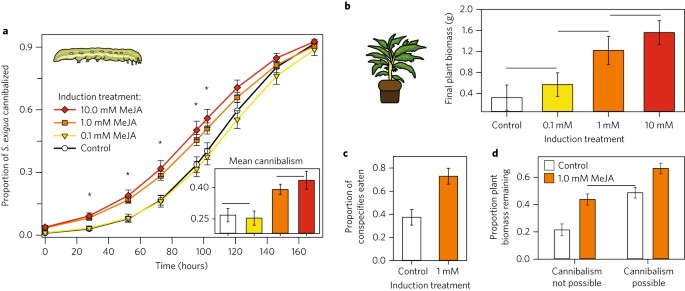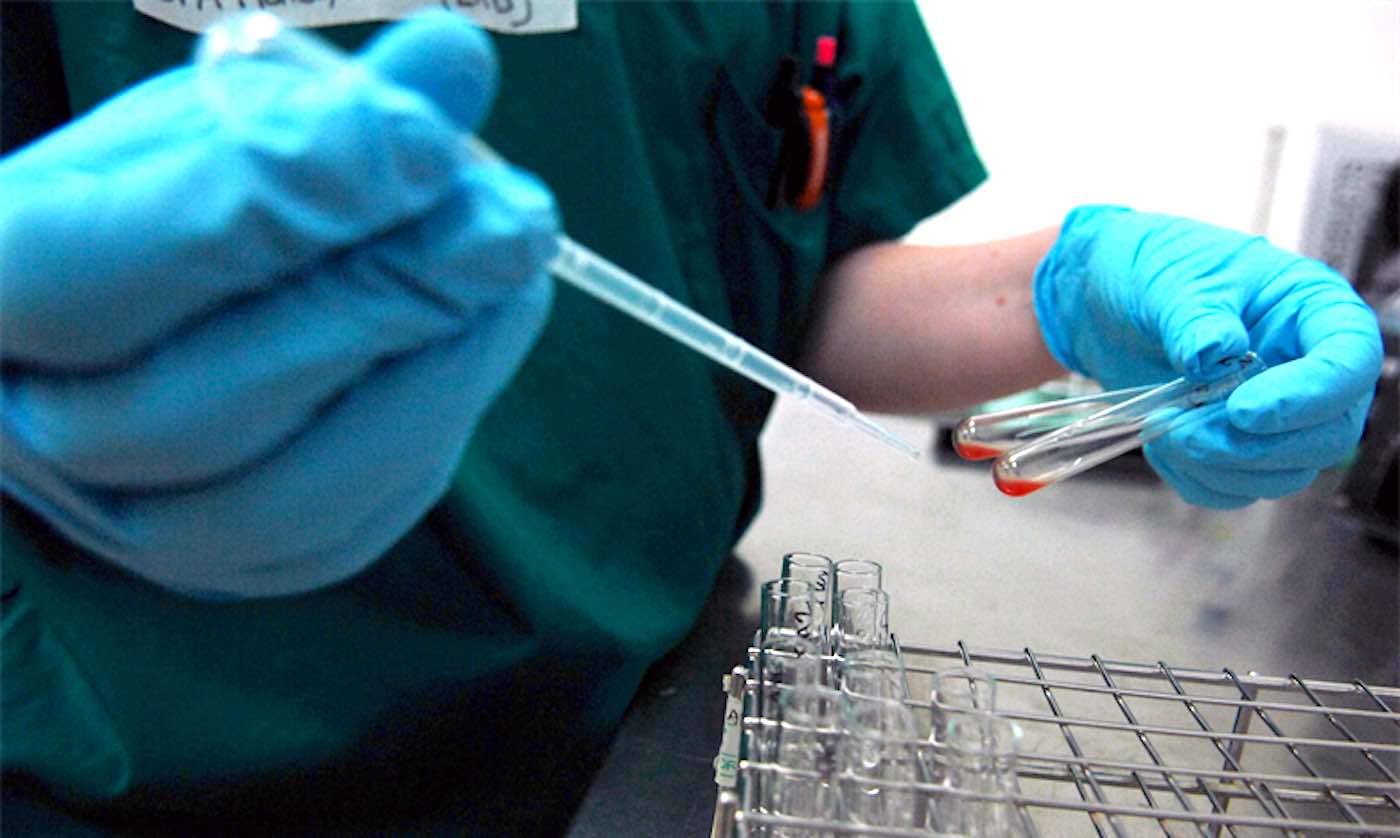
- Select a language for the TTS:
- UK English Female
- UK English Male
- US English Female
- US English Male
- Australian Female
- Australian Male
- Language selected: (auto detect) - EN
Play all audios:
ABSTRACT Plants are attacked by myriad herbivores, and many plants exhibit anti-herbivore defences. We tested the hypothesis that induced defences benefit tomato plants by encouraging
insects to eat other members of their species. We found that defences that promote cannibalism benefit tomatoes in two ways: cannibalism directly reduces herbivore abundance, and cannibals
eat significantly less plant material. This previously unknown means of defence may alter plant–herbivore dynamics, plant evolution and pathogen transmission. Access through your institution
Buy or subscribe This is a preview of subscription content, access via your institution ACCESS OPTIONS Access through your institution Access Nature and 54 other Nature Portfolio journals
Get Nature+, our best-value online-access subscription $29.99 / 30 days cancel any time Learn more Subscribe to this journal Receive 12 digital issues and online access to articles $119.00
per year only $9.92 per issue Learn more Buy this article * Purchase on SpringerLink * Instant access to full article PDF Buy now Prices may be subject to local taxes which are calculated
during checkout ADDITIONAL ACCESS OPTIONS: * Log in * Learn about institutional subscriptions * Read our FAQs * Contact customer support SIMILAR CONTENT BEING VIEWED BY OTHERS PLANT DEFENCE
TO SEQUENTIAL ATTACK IS ADAPTED TO PREVALENT HERBIVORES Article 14 October 2021 TOMATO DEFENCES MODULATE NOT ONLY INSECT PERFORMANCE BUT ALSO THEIR GUT MICROBIAL COMPOSITION Article Open
access 24 October 2023 COOPERATIVE HERBIVORY BETWEEN TWO IMPORTANT PESTS OF RICE Article Open access 19 November 2021 REFERENCES * Karban, R. & Baldwin, I. T. _Induced Responses to
Herbivory_ (Univ. Chicago Press, 1997). * Karban, R., Yang, L. H. & Edwards, K. F. _Ecol. Lett._ 17, 44–52 (2014). Article PubMed Google Scholar * Karban, R. _Plant Sensing and
Communication_ (Univ. Chicago Press, 2015). * Orrock, J. L. _et al_. _Trends Ecol. Evol._ 30, 441–445 (2015). Article PubMed Google Scholar * Agrawal, A. A. & Klein, C. N. _J. Anim.
Ecol._ 69, 525–535 (2000). Article Google Scholar * Poelman, E. H., van Loon, J. A. J. & Dicke, M. _Trends Plant Sci._ 13, 534–541 (2008). Article CAS PubMed Google Scholar *
Agrawal, A. A. _Funct. Ecol._ 25, 420–432 (2011). Article Google Scholar * Agrawal, A. A. _Entomol. Exp. Applic._ 115, 97–105 (2005). Article Google Scholar * Farmer, E. E. & Ryan,
C. A. _Proc. Natl Acad. Sci. USA_ 87, 7713–7716 (1990). Article CAS PubMed PubMed Central Google Scholar * Tian, D., Peiffer, M., De Moraes, C. M. & Felton, G. W. _Planta_ 239,
577–589 (2014). Article CAS PubMed Google Scholar * Richardson, M. L., Mitchell, R. F., Reagel, P. F. & Hanks, L. M. _Annu. Rev. Entomol._ 55, 39–53 (2010). Article CAS PubMed
Google Scholar * Fox, L. _Annu. Rev. Ecol. Syst._ 6, 87–106 (1975). Article Google Scholar * Al-Zubaidi, F. S. & Capinera, J. L. _Environ. Entomol._ 12, 1687–1689 (1983). Article
Google Scholar * Tian, D. _et al_. _PLoS One_ 7, e36168 (2012). Article CAS PubMed PubMed Central Google Scholar * Polis, G. A. _Annu. Rev. Ecol. Syst_ 12, 225–251 (1981). Article
Google Scholar * Andow, D. A. _et al_. _Ecol. Entomol._ 40, 229–236 (2005). Article Google Scholar * Karban, R., Agrawal, A. A., Thaler, J. S. & Adler, L. S. _Trends Ecol. Evol._ 14,
443–447 (1999). Article CAS PubMed Google Scholar * Sadeh, A. & Rosenheim, J. A. _Ecology_ 97, 1994–2002 (2016). Article PubMed Google Scholar * Thaler, J. S. _Nature_ 399,
686–688 (1999). Article CAS Google Scholar * Elvira, S., Williams, T. & Caballero, P. _J. Econ. Ent._ 103, 577–582 (2010). Article Google Scholar Download references
ACKNOWLEDGEMENTS Comments from E. Preisser and E. Damschen greatly improved the manuscript. We appreciate artwork by B. Feeny. J.O. was hosted by the Department of Biology at Virginia
Commonwealth University (VCU) while writing the manuscript; VCU Biology, the Johnson, Vonesh and Damschen laboratories kindly shared space and equipment for conducting experiments. AUTHOR
INFORMATION AUTHORS AND AFFILIATIONS * Department of Integrative Biology, University of Wisconsin, Madison, WI, 53704, USA John Orrock, Brian Connolly & Anthony Kitchen Authors * John
Orrock View author publications You can also search for this author inPubMed Google Scholar * Brian Connolly View author publications You can also search for this author inPubMed Google
Scholar * Anthony Kitchen View author publications You can also search for this author inPubMed Google Scholar CONTRIBUTIONS J.O. conceived the study; J.O. and B.C. designed the study; A.K.,
B.C. and J.O. conducted the experiments; J.O. performed all analyses and led manuscript preparation; B.C. and A.K. contributed to manuscript revision. CORRESPONDING AUTHOR Correspondence
to John Orrock. ETHICS DECLARATIONS COMPETING INTERESTS The authors declare no competing financial interests. ADDITIONAL INFORMATION PUBLISHER’S NOTE: Springer Nature remains neutral with
regard to jurisdictional claims in published maps and institutional affiliations. ELECTRONIC SUPPLEMENTARY MATERIAL SUPPLEMENTARY MATERIALS Supplementary Methods, Supplementary Results,
Supplementary References, Supplementary Figures 1–5 RIGHTS AND PERMISSIONS Reprints and permissions ABOUT THIS ARTICLE CITE THIS ARTICLE Orrock, J., Connolly, B. & Kitchen, A. Induced
defences in plants reduce herbivory by increasing cannibalism. _Nat Ecol Evol_ 1, 1205–1207 (2017). https://doi.org/10.1038/s41559-017-0231-6 Download citation * Received: 08 September 2016
* Accepted: 05 June 2017 * Published: 10 July 2017 * Issue Date: August 2017 * DOI: https://doi.org/10.1038/s41559-017-0231-6 SHARE THIS ARTICLE Anyone you share the following link with will
be able to read this content: Get shareable link Sorry, a shareable link is not currently available for this article. Copy to clipboard Provided by the Springer Nature SharedIt
content-sharing initiative








